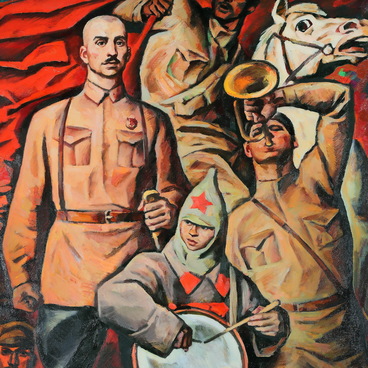Soviet artists often depicted the everyday life of various peoples of their large and multiethnic country. Alexander Vladimirovich Yurkin joined in the trend with his “Young Zyryans”.
The name of the painting refers to one of the Ural peoples belonging to the Finno-Ugric language group. Zyryan is the Russian version of the people’s name. The people of this nation call themselves Komi Mort speaking of a Komi person or Komi Voityr designating the entire Komi people.
The Komi people are the indigenous population of the Komi Republic and they are also present in other parts of Russia such as the Arkhangelsk, Murmansk, Omsk, Sverdlovsk, and Tyumen regions, as well as the Nenets, Yamal-Nenets, and Khanty-Mansi Autonomous Okrugs.
The Komi people are one of the most famous reindeer herders of the European North. In ancient times, along with the main occupations of the indigenous peoples, such as agriculture, animal husbandry, hunting, and fishing, there was also reindeer husbandry actively developing in the northern regions. It made some ethnographic groups of the Komi switch to a nomadic way of life. The people had some settlements scattered over the territory, but they were treated only as selling and processing points for reindeer products.
The painting “Young Zyryans” is set in a snow-covered forest. In the foreground are two traditionally dressed girls sitting on a log. The background reveals the camp of reindeer breeders with raw-hide tents, sleds, and a few domestic deer.
The colorful outfits that the girls in the picture are wearing demonstrate how the Komi adapted to the weather conditions they lived in. The Northern Komi widely borrowed clothes from the Nenets and integrated the malitsa (a deerskin parka), sovik (shirtlike hooded fur coat), and pima (deerskin boots) into their culture.
A malitsa is a buttoned-up fur outerwear sewn from deerskin. It was worn by both men and women from the age of 5 or 6. Its cut resembles that of an oversize shirt that extends to the knees with its front side being a little shorter. In frosts and blizzards, a sovik was put on over a malitsa. It was sewn wool outside from a dense skin of an autumn or winter deer and it had no belt. The Komi also wore pima fur boots. In summer, the sovik was still made of dense cloth for even in August the air temperature in those northern lands did not rise above +15 °C.
The name of the painting refers to one of the Ural peoples belonging to the Finno-Ugric language group. Zyryan is the Russian version of the people’s name. The people of this nation call themselves Komi Mort speaking of a Komi person or Komi Voityr designating the entire Komi people.
The Komi people are the indigenous population of the Komi Republic and they are also present in other parts of Russia such as the Arkhangelsk, Murmansk, Omsk, Sverdlovsk, and Tyumen regions, as well as the Nenets, Yamal-Nenets, and Khanty-Mansi Autonomous Okrugs.
The Komi people are one of the most famous reindeer herders of the European North. In ancient times, along with the main occupations of the indigenous peoples, such as agriculture, animal husbandry, hunting, and fishing, there was also reindeer husbandry actively developing in the northern regions. It made some ethnographic groups of the Komi switch to a nomadic way of life. The people had some settlements scattered over the territory, but they were treated only as selling and processing points for reindeer products.
The painting “Young Zyryans” is set in a snow-covered forest. In the foreground are two traditionally dressed girls sitting on a log. The background reveals the camp of reindeer breeders with raw-hide tents, sleds, and a few domestic deer.
The colorful outfits that the girls in the picture are wearing demonstrate how the Komi adapted to the weather conditions they lived in. The Northern Komi widely borrowed clothes from the Nenets and integrated the malitsa (a deerskin parka), sovik (shirtlike hooded fur coat), and pima (deerskin boots) into their culture.
A malitsa is a buttoned-up fur outerwear sewn from deerskin. It was worn by both men and women from the age of 5 or 6. Its cut resembles that of an oversize shirt that extends to the knees with its front side being a little shorter. In frosts and blizzards, a sovik was put on over a malitsa. It was sewn wool outside from a dense skin of an autumn or winter deer and it had no belt. The Komi also wore pima fur boots. In summer, the sovik was still made of dense cloth for even in August the air temperature in those northern lands did not rise above +15 °C.
